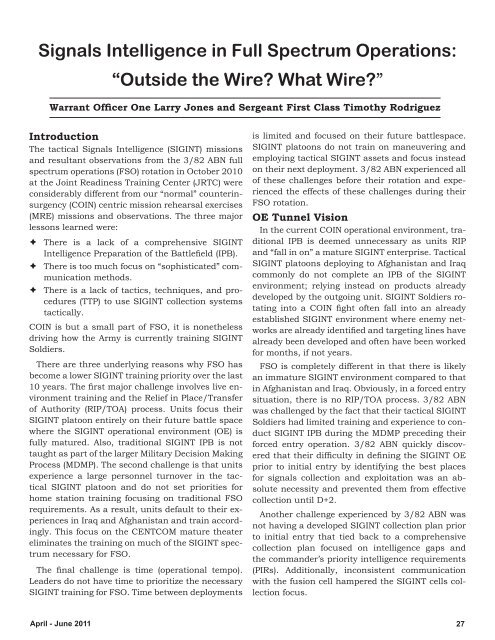George w. casey jr. - Federation of American Scientists
George w. casey jr. - Federation of American Scientists
George w. casey jr. - Federation of American Scientists
You also want an ePaper? Increase the reach of your titles
YUMPU automatically turns print PDFs into web optimized ePapers that Google loves.
Signals Intelligence in Full Spectrum Operations:<br />
“Outside the Wire? What Wire?”<br />
Warrant Officer One Larry Jones and Sergeant First Class Timothy Rodriguez<br />
Introduction<br />
The tactical Signals Intelligence (SIGINT) missions<br />
and resultant observations from the 3/82 ABN full<br />
spectrum operations (FSO) rotation in October 2010<br />
at the Joint Readiness Training Center (JRTC) were<br />
considerably different from our “normal” counterinsurgency<br />
(COIN) centric mission rehearsal exercises<br />
(MRE) missions and observations. The three major<br />
lessons learned were:<br />
There is a lack <strong>of</strong> a comprehensive SIGINT<br />
Intelligence Preparation <strong>of</strong> the Battlefield (IPB).<br />
There is too much focus on “sophisticated” communication<br />
methods.<br />
There is a lack <strong>of</strong> tactics, techniques, and procedures<br />
(TTP) to use SIGINT collection systems<br />
tactically.<br />
COIN is but a small part <strong>of</strong> FSO, it is nonetheless<br />
driving how the Army is currently training SIGINT<br />
Soldiers.<br />
There are three underlying reasons why FSO has<br />
become a lower SIGINT training priority over the last<br />
10 years. The first major challenge involves live environment<br />
training and the Relief in Place/Transfer<br />
<strong>of</strong> Authority (RIP/TOA) process. Units focus their<br />
SIGINT platoon entirely on their future battle space<br />
where the SIGINT operational environment (OE) is<br />
fully matured. Also, traditional SIGINT IPB is not<br />
taught as part <strong>of</strong> the larger Military Decision Making<br />
Process (MDMP). The second challenge is that units<br />
experience a large personnel turnover in the tactical<br />
SIGINT platoon and do not set priorities for<br />
home station training focusing on traditional FSO<br />
requirements. As a result, units default to their experiences<br />
in Iraq and Afghanistan and train accordingly.<br />
This focus on the CENTCOM mature theater<br />
eliminates the training on much <strong>of</strong> the SIGINT spectrum<br />
necessary for FSO.<br />
The final challenge is time (operational tempo).<br />
Leaders do not have time to prioritize the necessary<br />
SIGINT training for FSO. Time between deployments<br />
is limited and focused on their future battlespace.<br />
SIGINT platoons do not train on maneuvering and<br />
employing tactical SIGINT assets and focus instead<br />
on their next deployment. 3/82 ABN experienced all<br />
<strong>of</strong> these challenges before their rotation and experienced<br />
the effects <strong>of</strong> these challenges during their<br />
FSO rotation.<br />
OE Tunnel Vision<br />
In the current COIN operational environment, traditional<br />
IPB is deemed unnecessary as units RIP<br />
and “fall in on” a mature SIGINT enterprise. Tactical<br />
SIGINT platoons deploying to Afghanistan and Iraq<br />
commonly do not complete an IPB <strong>of</strong> the SIGINT<br />
environment; relying instead on products already<br />
developed by the outgoing unit. SIGINT Soldiers rotating<br />
into a COIN fight <strong>of</strong>ten fall into an already<br />
established SIGINT environment where enemy networks<br />
are already identified and targeting lines have<br />
already been developed and <strong>of</strong>ten have been worked<br />
for months, if not years.<br />
FSO is completely different in that there is likely<br />
an immature SIGINT environment compared to that<br />
in Afghanistan and Iraq. Obviously, in a forced entry<br />
situation, there is no RIP/TOA process. 3/82 ABN<br />
was challenged by the fact that their tactical SIGINT<br />
Soldiers had limited training and experience to conduct<br />
SIGINT IPB during the MDMP preceding their<br />
forced entry operation. 3/82 ABN quickly discovered<br />
that their difficulty in defining the SIGINT OE<br />
prior to initial entry by identifying the best places<br />
for signals collection and exploitation was an absolute<br />
necessity and prevented them from effective<br />
collection until D+2.<br />
Another challenge experienced by 3/82 ABN was<br />
not having a developed SIGINT collection plan prior<br />
to initial entry that tied back to a comprehensive<br />
collection plan focused on intelligence gaps and<br />
the commander’s priority intelligence requirements<br />
(PIRs). Additionally, inconsistent communication<br />
with the fusion cell hampered the SIGINT cells collection<br />
focus.<br />
April - June 2011 27















